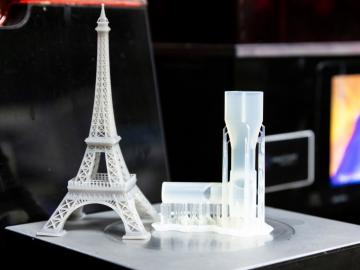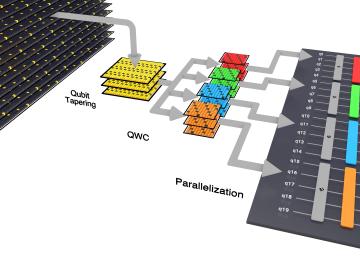
Filter News
Area of Research
- (-) National Security (45)
- (-) Supercomputing (153)
- Advanced Manufacturing (5)
- Biological Systems (1)
- Biology and Environment (102)
- Biology and Soft Matter (4)
- Building Technologies (2)
- Chemical and Engineering Materials (3)
- Chemistry and Physics at Interfaces (7)
- Clean Energy (168)
- Climate and Environmental Systems (7)
- Computational Biology (1)
- Computational Chemistry (5)
- Computational Engineering (1)
- Computer Science (3)
- Data (1)
- Earth Sciences (1)
- Electricity and Smart Grid (1)
- Energy Frontier Research Centers (7)
- Fuel Cycle Science and Technology (2)
- Functional Materials for Energy (8)
- Fusion and Fission (32)
- Fusion Energy (7)
- Geographic Information Science and Technology (1)
- Isotopes (21)
- Materials (122)
- Materials for Computing (13)
- Materials Synthesis from Atoms to Systems (8)
- Materials Under Extremes (7)
- Neutron Data Analysis and Visualization (2)
- Neutron Science (72)
- Nuclear Science and Technology (27)
- Quantum Condensed Matter (3)
- Quantum information Science (4)
- Renewable Energy (2)
- Sensors and Controls (2)
- Transportation Systems (4)
News Type
News Topics
- 3-D Printing/Advanced Manufacturing (3)
- Artificial Intelligence (25)
- Big Data (15)
- Bioenergy (4)
- Biology (8)
- Biomedical (7)
- Biotechnology (2)
- Buildings (2)
- Chemical Sciences (1)
- Climate Change (15)
- Computer Science (49)
- Coronavirus (8)
- Cybersecurity (8)
- Decarbonization (4)
- Energy Storage (1)
- Environment (16)
- Exascale Computing (12)
- Frontier (13)
- Grid (4)
- High-Performance Computing (22)
- Machine Learning (13)
- Materials (5)
- Materials Science (9)
- Mathematics (1)
- Microscopy (2)
- Nanotechnology (5)
- National Security (23)
- Net Zero (1)
- Neutron Science (7)
- Nuclear Energy (3)
- Physics (3)
- Quantum Computing (10)
- Quantum Science (11)
- Security (6)
- Simulation (10)
- Software (1)
- Space Exploration (1)
- Summit (21)
- Sustainable Energy (3)
- Transportation (3)
Media Contacts

Mike Huettel is a cyber technical professional. He also recently completed the 6-month Cyber Warfare Technician course for the United States Army, where he learned technical and tactical proficiency leadership in operations throughout the cyber domain.

Autonomous labs are changing the nature of scientific investigation. Instead of humans manually orchestrating every part of an experiment, programmed equipment can carry out necessary functions. This workflow accelerates the pace of discovery by reducing the number of monotonous tasks that researchers must perform.

Cody Lloyd became a nuclear engineer because of his interest in the Manhattan Project, the United States’ mission to advance nuclear science to end World War II. As a research associate in nuclear forensics at ORNL, Lloyd now teaches computers to interpret data from imagery of nuclear weapons tests from the 1950s and early 1960s, bringing his childhood fascination into his career

ORNL, the Department of Energy’s largest multidisciplinary laboratory, and Fairbanks Morse Defense, a portfolio company of Arcline Investment Management, have entered into a Memorandum of Understanding to collaborate on the development and integration of alternative fuel technologies aimed at reducing the marine engine’s reliance on fossil fuels.

Hosted by the Quantum Computing Institute and the Oak Ridge Leadership Computing Facility, the fourth annual event brought together over 100 attendees to discuss the latest developments in quantum computing and to learn about results from projects supported by the OLCF’s Quantum Computing User Program.

ORNL hosted its fourth Artificial Intelligence for Robust Engineering and Science, or AIRES, workshop from April 18-20. Over 100 attendees from government, academia and industry convened to identify research challenges and investment areas, carving the future of the discipline.

Quantum computing sits on the cutting edge of scientific discovery. Given its novelty, the next generation of researchers will contribute significantly to the advancement of the field. However, this new crop of scientists must first be cultivated.

After completing a bachelor’s degree in biology, Toya Beiswenger didn’t intend to go into forensics. But almost two decades later, the nuclear security scientist at ORNL has found a way to appreciate the art of nuclear forensics.

Using the full capabilities of the Quantinuum H1-1 quantum computer, researchers from ORNL not only demonstrated best practices for scientific computing on current quantum systems but also produced an intriguing scientific result.

Wildfires have shaped the environment for millennia, but they are increasing in frequency, range and intensity in response to a hotter climate. The phenomenon is being incorporated into high-resolution simulations of the Earth’s climate by scientists at the Department of Energy’s Oak Ridge National Laboratory, with a mission to better understand and predict environmental change.


